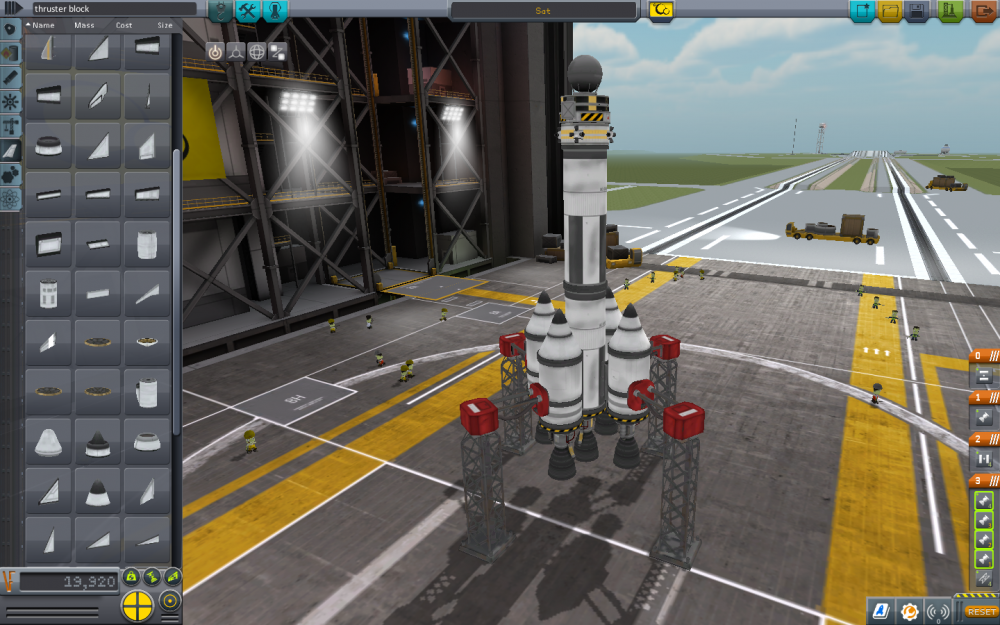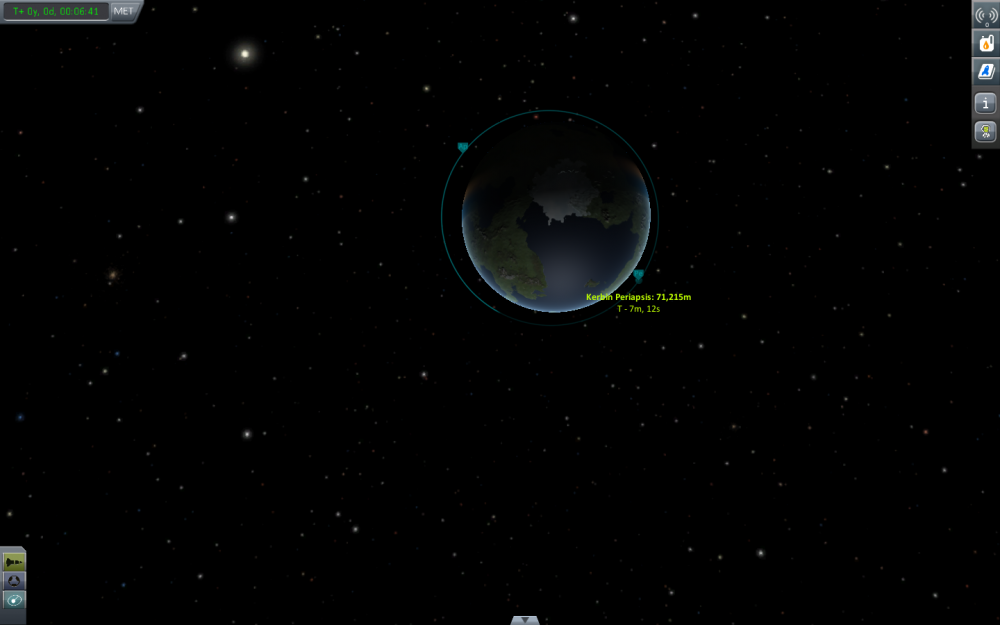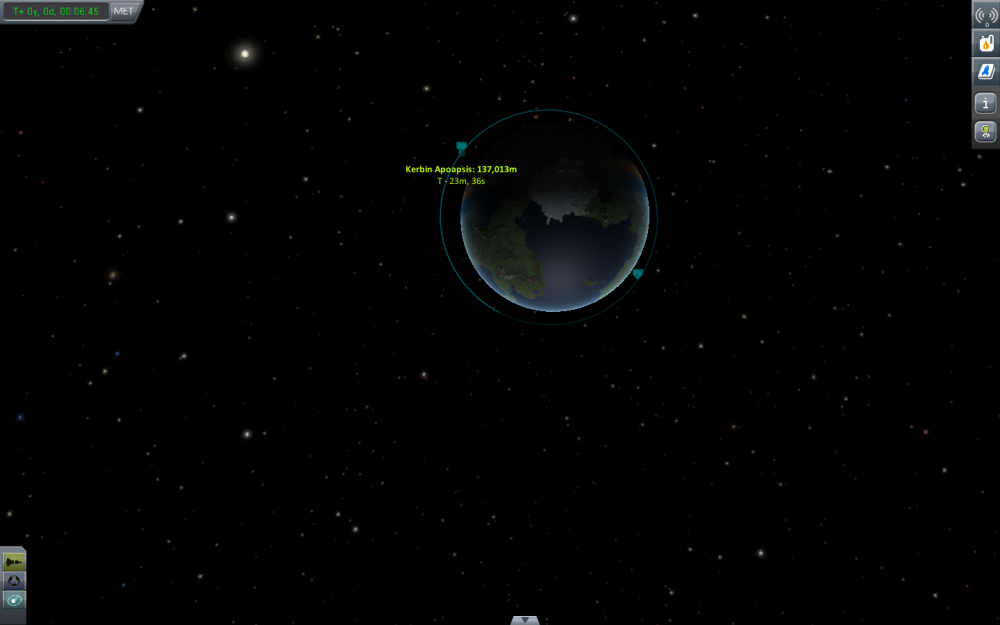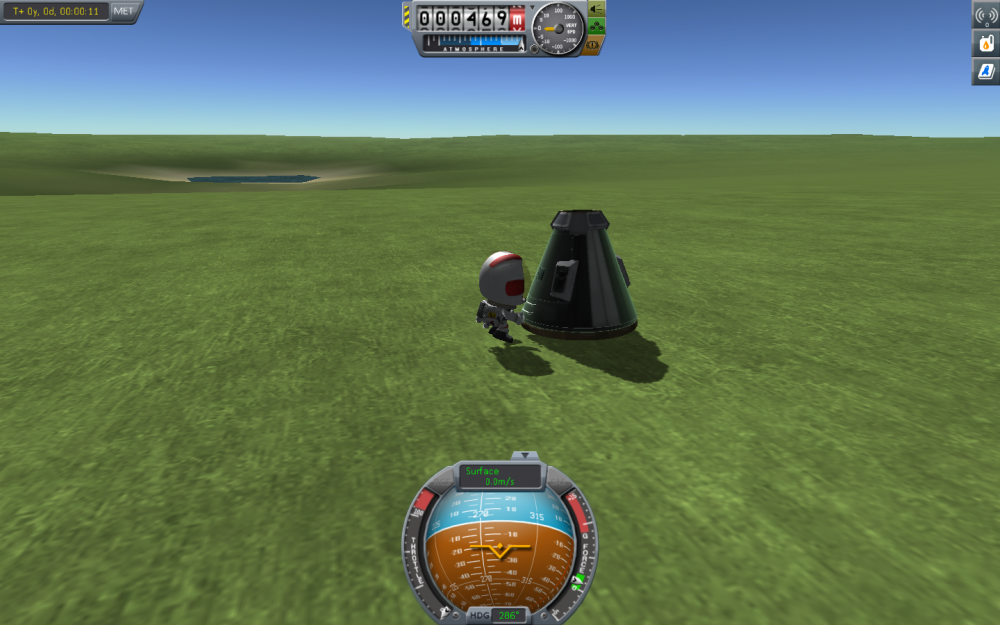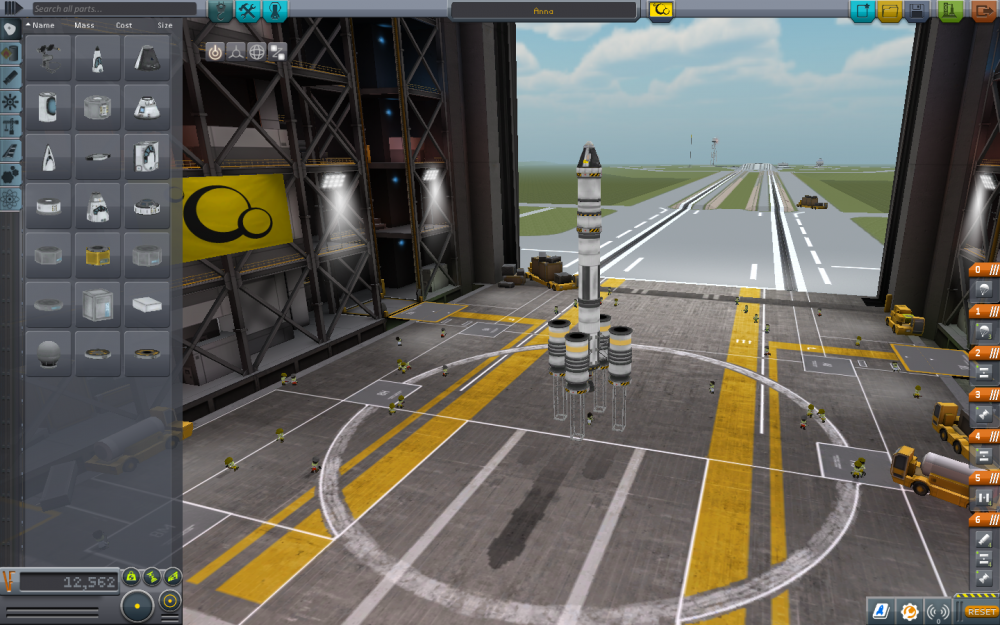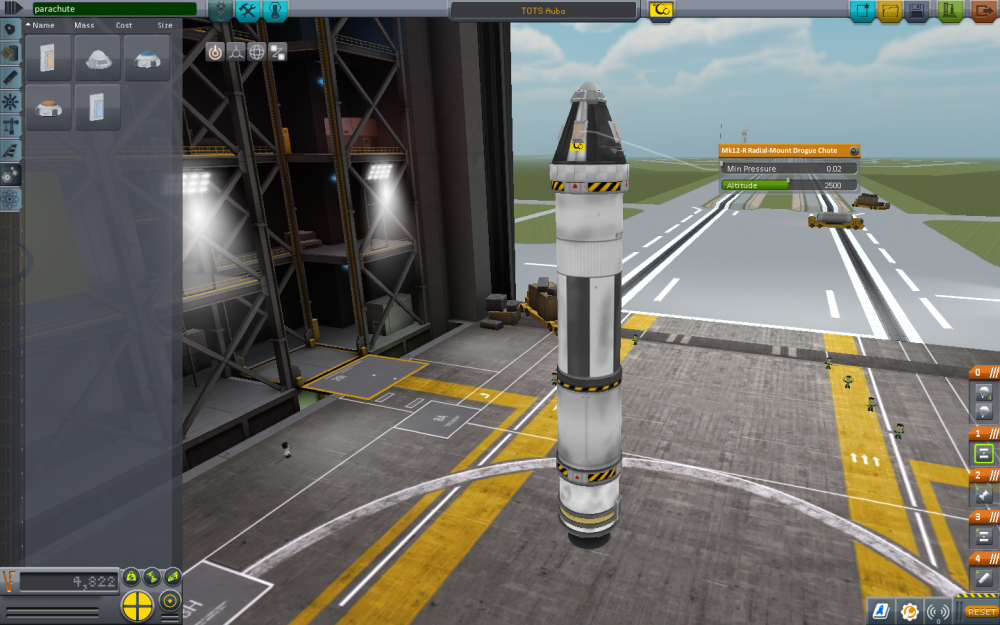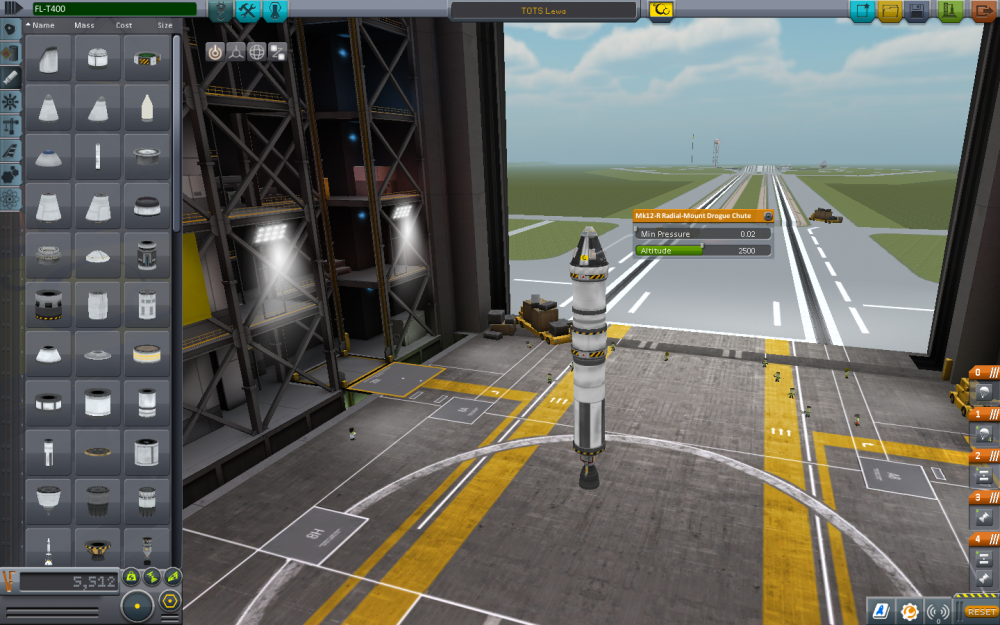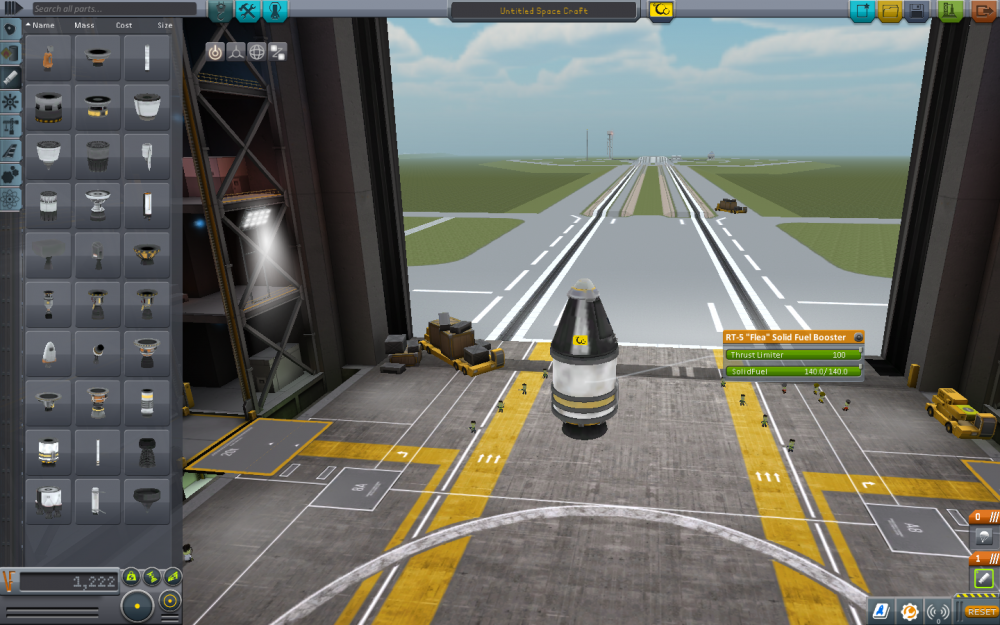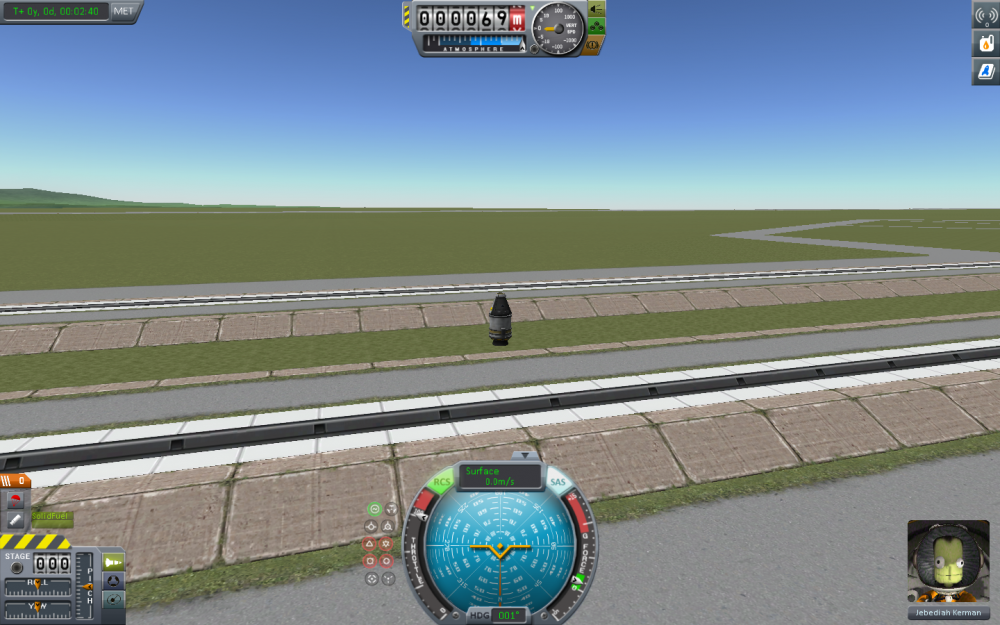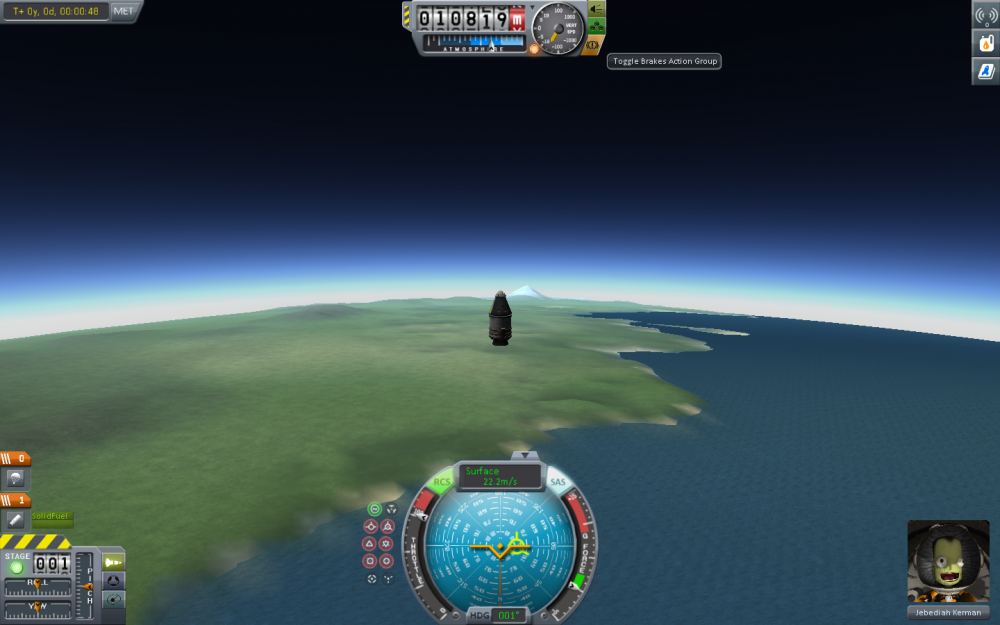
ncharles
Members-
Posts
47 -
Joined
-
Last visited
Content Type
Profiles
Forums
Downloads
Blogs
Events
Store
Everything posted by ncharles
-
Team Name: Channarney Available Funds: $59,340 Vehicle Name: Orbit Vehicle Parts List and Cost: $23,070 Payload stage 1x Stayputnik Mk. 1 1x Z-1k Rechargable Battery Bank Second stage 1x TR-18A Stack Decoupler 1x FL-R25 RCS Fuel Tank 4x RV-105 RCS Thruster Block (symmetric radial-mounted) 1x FL-T800 Fuel Tank 1x LV-T30 Liquid Fuel Engine First stage 4x TT-38K Radial Decoupler 4x FL-T400 Fuel Tank 4x Aerodynamic Nose Cone 4x LV-T30 Liquid Fuel Engine 4x Launch Stabilizers RC-001S Remote Guidance Unit Design Goals: The rocket has enough fuel to launch itself into orbit (70km). Once we are able to establish orbit, we will decouple and put the satellite in a stable orbit around Kerbin. Launch Goal: The vehicle is designed to orbit Kerbin and the put a satellite in a stable orbit. Pilot Plan: Launch with boosters and first engine, shed boosters when the run out. Begin turning at 10km and follow the marker on the position ball. One the apoapse is at 80km cut the engine and create node to circularize the orbit. Burn the engine when it says to and orbit is achieved. Then, decouple and allow the satellite to orbit freely.
-
Launch Time: 10:50 Team Members Present: Anna, Nate, Trevor Play-by-Play: Everything went smoothly until we attempted to turn into orbit and when we tried the rocket wouldn't turn so the flight failed. Photographs: none Time-of-Flight: 5:00 Summary: our goal of a satellite was not achieved. Opportunities / Learnings: We need to rethink our original design because the rocket has turned twice in the past two flights, causing them to fail. Strategies / Project Timeline: We are going to reattempt the satellite launch. Milestone Awards Presented: none Available Funds: 80,706-21,420= $59,340
-
Launch Time: 10:40 Team Members Present: Anna, Nate, Trevor Play-by-Play: Everything went smoothly until we attempted to turn into orbit and when we tried the rocket wouldn't turn so the flight failed Photographs: none Time-of-Flight: 10:12 Summary: our goal of a satellite was not achieved Opportunities / Learnings: We now know what engine to use to get into orbit Strategies / Project Timeline: We are ready get a satellite into orbit Milestone Awards Presented: none Available Funds:98,908-18,102=80,706 Team Name: Channarney Available Funds: $80,806 Vehicle Name: Sat 2 Vehicle Parts List and Cost: $21,420 Payload stage 1x Stayputnik Mk. 1 1x Z-1k Rechargable Battery Bank Second stage 1x TR-18A Stack Decoupler 1x FL-R25 RCS Fuel Tank 4x RV-105 RCS Thruster Block (symmetric radial-mounted) 1x FL-T800 Fuel Tank 1x LV-T45 Liquid Fuel Engine First stage 4x TT-38K Radial Decoupler 4x FL-T400 Fuel Tank 4x Aerodynamic Nose Cone 4x LV-T30 Liquid Fuel Engine 4x Launch Stabilizers Design Goals: The rocket has enough fuel to launch itself into orbit (70km). Once we are able to establish orbit, we will decouple and put the satellite in a stable orbit around Kerbin. Launch Goal: The vehicle is designed to orbit Kerbin and the put a satellite in a stable orbit. Pilot Plan: Launch with boosters and first engine, shed boosters when the run out. Begin turning at 10km and follow the marker on the position ball. One the apoapse is at 80km cut the engine and create node to circularize the orbit. Burn the engine when it says to and orbit is achieved. Then, decouple and allow the satellite to orbit freely.
-
Team Name: Channarney Available Funds: $98,908 Vehicle Name: Sat Vehicle Parts List and Cost: $18,102 Payload stage 1x Stayputnik Mk. 1 1x Z-1k Rechargable Battery Bank Second stage 1x TR-18A Stack Decoupler 1x FL-R25 RCS Fuel Tank 4x RV-105 RCS Thruster Block (symmetric radial-mounted) 1x FL-T800 Fuel Tank 1x LV-T30 Liquid Fuel Engine First stage 4x TT-38K Radial Decoupler 4x FL-T400 Fuel Tank 4x Aerodynamic Nose Cone 4x LV-T30 Liquid Fuel Engine 4x Launch Stabilizers Design Goals: The rocket has enough fuel to launch itself into orbit (70km). Once we are able to establish orbit, we will decouple and put the satellite in a stable orbit around Kerbin. Launch Goal: The vehicle is designed to orbit Kerbin and the put a satellite in a stable orbit. Pilot Plan: Launch with boosters and first engine, shed boosters when the run out. Begin turning at 10km and follow the marker on the position ball. One the apoapse is at 80km cut the engine and create node to circularize the orbit. Burn the engine when it says to and orbit is achieved. Then, decouple and allow the satellite to orbit freely.
-
Launch Time: 10:40 Team Members Present: Anna, Nate, Trevor Play-by-Play: Boosters cut out at 5km and were then shed. The throttle was put to the maximum as the trajectory of the flight was tilted for orbit. Main engine was cut when the apoapsis was at 90km. A 71km by 130km orbit was achieved with enough fuel to return safely. The decent went very smoothly as we deploy the initial parachutes at 420 m/s and the main chute at 220 m/s and landed successfully. Photographs: attached Time-of-Flight: 22:37 Summary: our goal of orbit and return was achieved and we are now ready to shoot for the moon! Opportunities / Learnings: We now know the amount of fuel we need to get into orbit and return home. Strategies / Project Timeline: We are ready to land on the moon Milestone Awards Presented: Stable manned orbit ($50,000) Available Funds: $48,908 + 50,000 = $98,908
-
Team Name: Channarney Available Funds: $61,470 Vehicle Name: Trevor Vehicle Parts List and Cost: Command Pod Mk1, mk16 Parachute, Heat Shield, TR-18A Stack Decoupler, FL-T800 Fuel Tank, FL-T400 Fuel Tank, LV-T45 Liquid Fuel Engine, LV-909 Liquid Fuel Engine, Mk12-R Radial-Mount Drogue Chute, RT-10 Solid Fuel Booster, Modular Girder Segment XL Total Cost: $12,562 Design Goals: The rocket has enough fuel to launch itself into orbit (70km). It will still have enough fuel to get out of orbit and return to Kerbin. Then, the heat shield is necessary in order to prevent burn up upon reentry. The Mk12 chute slows the rocket down to an optimal speed for the mk16 chute to deploy without burning up. Launch Goal: The vehicle is designed to orbit Kerbin and return safely. Pilot Plan: Launch with boosters and first engine, shed boosters when the run out. Begin turning at 10km and follow the marker on the position ball. One the apoapse is at 80km cut the engine and create node to circularize the orbit. Burn the engine when it says to and orbit is achieved. To get back, burn retrograde (backwards) until the periapses is less than 35km. Fall into the atmosphere and deploy the chutes when necessary. Team Name: Channarney Available Funds: $48,908 Vehicle Name: Anna Vehicle Parts List and Cost: Command Pod Mk1, mk16 Parachute, Heat Shield, TR-18A Stack Decoupler, FL-T800 Fuel Tank, FL-T400 Fuel Tank, LV-T45 Liquid Fuel Engine, LV-909 Liquid Fuel Engine, Mk12-R Radial-Mount Drogue Chute, RT-10 Solid Fuel Booster, Modular Girder Segment XL Total Cost: $12,562 Design Goals: The rocket has enough fuel to launch itself into orbit (70km). It will still have enough fuel to get out of orbit and return to Kerbin. Then, the heat shield is necessary in order to prevent burn up upon reentry. The Mk12 chute slows the rocket down to an optimal speed for the mk16 chute to deploy without burning up. Launch Goal: The vehicle is designed to orbit Kerbin and return safely. Pilot Plan: Launch with boosters and first engine, shed boosters when the run out. Begin turning at 10km and follow the marker on the position ball. One the apoapse is at 80km cut the engine and create node to circularize the orbit. Burn the engine when it says to and orbit is achieved. To get back, burn retrograde (backwards) until the periapses is less than 35km. Fall into the atmosphere and deploy the chutes when necessary.
-
Team Name: Channarney Available Funds: $73,232 Vehicle Name: TOTY Messi Vehicle Parts List and Cost: Command Pod Mk1, mk16 Parachute, Heat Shield, TR-18A Stack Decoupler, FL-T800 Fuel Tank, FL-T400 Fuel Tank, LV-T45 Liquid Fuel Engine, LV-909 Liquid Fuel Engine, Mk12-R Radial-Mount Drogue Chute, RT-10 Solid Fuel Booster, Modular Girder Segment XL Total Cost: 11,762 Design Goals: The rocket has enough fuel to launch itself into orbit (70km). It will still have enough fuel to get out of orbit and return to Kerbin. Then, the heat shield is necessary in order to prevent burn up upon reentry. The Mk12 chute slows the rocket down to an optimal speed for the mk16 chute to deploy without burning up. Launch Goal: The vehicle is designed to orbit Kerbin and return safely. Pilot Plan: Launch with boosters and first engine, shed boosters when the run out. Begin turning at 10km and follow the marker on the position ball. One the apoapse is at 80km cut the engine and create node to circularize the orbit. Burn the engine when it says to and orbit is achieved. To get back, burn retrograde (backwards) until the periapses is less than 35km. Fall into the atmosphere and deploy the chutes when necessary.
-
Launch Time: 10:40 Team Members Present: Anna, Nate, Trevor Play-by-Play: The throttle was put to the maximum at launch. The engine cut out at 3km then switched to the next engine to get into orbit. However we did not have enough fuel to get into orbit and we fell back to earth. We landed safely, deploying the chutes when necessary. Photographs: none Time-of-Flight: 16:12 Summary: If we had more fuel, we would have made orbit but we didn't. Opportunities / Learnings: We now know the amount of fuel we need to get into orbit and return home. Strategies / Project Timeline: We are ready to get into orbit. Milestone Awards Presented:None. Available Funds: $73,232
-
Team Name: Channarney Available Funds: $78,094 Vehicle Name: TOTY Ronny Vehicle Parts List and Cost: Command Pod Mk1, mk16 Parachute, Heat Shield, TR-18A Stack Decoupler, FL-T800 Fuel Tank, FL-T400 Fuel Tank, LV-T30 Liquid Fuel Engine, LV-909 Liquid Fuel Engine, Mk12-R Radial-Mount Drogue Chute Total Cost: $4,862. Design Goals: The rocket has enough fuel to launch itself into orbit (70km). It will still have enough fuel to get out of orbit and return to Kerbin. Then, the heat shield is necessary in order to prevent burn up upon reentry. The Mk12 chute slows the rocket down to an optimal speed for the mk16 chute to deploy without burning up. Launch Goal: The vehicle is designed to orbit Kerbin and return safely. Pilot Plan: Launch reach 300 m/s and attain that speed until 10km then return to full throttle. Begin turning east at 10km and gradually reach a 45 degree turn by 50km. First engine should be detached by 20km. Immediately fire the second engine. Once the highest point is at 70km, keep that point about 30 seconds away until the orbit is circular around Kerbin. Then cut the engine. To re enter, turn the rocket and fire in the opposite direction to begin decent. Deploy mk12 chutes at 420m/s and the mk16 chute at 220 m/s for safe landing.
-
Launch Time: 10:55 Team Members Present: Anna, Nate, Trevor Play-by-Play: The throttle was put to the maximum at launch. The booster cut out at 500m and then the second engine was fired. The second engine was cut at 21km . The rocket reached 74,000 meters but on descent, the parachutes successfully deployed on entry into the atmosphere and we landed safely Photographs: See attachements Time-of-Flight: 6:23 Summary: We surpassed 50,00 meters and accidently kept going to 73,000 m. Then on reentry the parachutes deployed and we landed successfully. Opportunities / Learnings: We learned how to use multiple engines in different steps during the mission. We learned from our mistakes in our previous launch and deployed our parachutes at a more optimal time. Strategies / Project Timeline: We are ready to continue flying higher. Milestone Awards Presented: 50 manned km reached. Available Funds: $48,094. The max height screenshot was deleted on accident.
-
Launch Time: 10:50 Team Members Present: Anna, Nate, Trevor Play-by-Play: The throttle was put to the maximum at launch. The first engine cut out at 18 km and then the second engine was fired. The second engine was cut at 32,000 meters. The rocket reached 67,000 meters but on descent, the parachutes burned up and Jebediah died :(. Photographs: See attachements Time-of-Flight: 5:13 Summary: Although we surpassed 50,00 meters, reaching almost 70,000 m, our reentry was way too fast, so we were not able to deploy our parachutes in time, causing a huge explosion that unfortunately killed Jebediah. We are extremely saddened by the loss of our kerbal and we hope that this unfortunate incident does not dampen our mission to bring people to space. Opportunities / Learnings: We learned how to use multiple engines in different steps during the mission. We also learned that we had way too much fuel in the rocket, which caused us to go way to high and to unfortunately crash our ship. Finally, we learned that upon reentering the atmosphere, the ship begins to decelerate. Strategies / Project Timeline: We are ready to reattempt launch by using the information we learned from this failure. Milestone Awards Presented: None Available Funds: $58,778 (before the costs and penalty). $52,916. Team Name: Channarney Available Funds: $52,916 Vehicle Name: TOTS Auba Vehicle Parts List and Cost: Command Pod Mk1, mk16 Parachute, Heat Shield, TR-18A Stack Decoupler, FL-T800 Fuel Tank, LV-T30 Liquid Fuel Engine, Mk12-R Radial-Mount Drogue Chute, RT-5 Solid Fuel Booster . Total Cost: $4,822. Design Goals: The rocket has enough fuel to launch itself to 50,000 m. Then, the heat shield is necessary in order to prevent burn up upon reentry. The Mk12 chute slows the rocket down to an optimal speed for the mk16 chute to deploy without burning up. Launch Goal: The vehicle is designed to reach an altitude of 50,000 meters and return safely to the ground. Pilot Plan: To launch: Full throttle. When the booster runs out of fuel, detach it. Then fire the next engine. Cut the engine at 30,000m. Then, on descent, deploy the Mk12 at 420 m/s after is has entered the atmosphere and deploy the Mk16 chute when the rocket has reached a downfall speed of 260 m/s.
-
Team Name: Channarney Available Funds: $58,778 Vehicle Name: TOTS Lewa Vehicle Parts List and Cost: Command Pod Mk1, mk16 Parachute, Heat Shield, TR-18A Stack Decoupler, FL-T400 Fuel Tank, LV-909 Liquid Fuel Engine, FL-T800 Fuel Tank, LV-T30 Liquid Fuel Engine, Mk12-R Radial-Mount Drogue Chute. Total Cost: $4,862. Design Goals: The rocket has enough fuel to launch itself to 50,000 m. Then, the heat shield is necessary in order to prevent burn up upon reentry. The Mk12 chute slows the rocket down to an optimal speed for the mk16 chute to deploy without burning up. Launch Goal: The vehicle is designed to reach an altitude of 50,000 meters and return safely to the ground. Pilot Plan: To launch: Full throttle. When the first liquid fuel engine runs out of fuel, detach it. Then fire the next engine. Cut the engine at 40,000 m. Then, on descent, deploy the Mk12 at 420 m/s and deploy the Mk16 chute when the rocket has reached a downfall speed of 260 m/s.
-
Team Name: Channarney Available Funds: $30,000 Vehicle Name: Naters FC Vehicle Parts List and Cost: MK1 Command Pod ($600), MK16 Parachute ($422), RT-5 Solid Fuel Booster ($200) Design Goals: The booster is used to help the rocket reach 10,000 meters. The parachute then serves as the drag force to slow the return to the grounf. Launch Goal: The vehicle is designed to reach an altitude of 10,000 meters and return safely to the ground. Pilot Plan: To launch: Full throttle. Parachute deployed at 4,000 m descent. Illustrations: Launch Time: 10:49 Team Members Present: Anna, Nate, Trevor Play-by-Play: The throttle was put to the maximum at launch. The throttle cut out at 5500 m and the rocket made it to 10800 m. Parachute deployed 3800 m and landed safely. Photographs: See attachements Time-of-Flight: 3:50 Summary: As a result of the launch, we reached 10,000 m with a single booster engine and we returned the kerbel safely back to the ground. As a result of our success, we are ready to launch to higher heights. We are proud to have this successful mission so that we can bring reality to space and persevere in our goals. We hope that people will continue following our journey and support us. Opportunities / Learnings: Basic building of rocket and launching techniques. Also, we saw that the booster can cut out and the rocket can still go higher after. Strategies / Project Timeline: We are ready to go higher and attempt to achieve orbit. Milestone Awards Presented: Launched to 10km (10,000) and manned launch to 10km ($20,000) Available Funds: $28,778 (before the added award). $58,778 after awards.
-
If you have ever went to see a concert, play, musical or any other performance on a stage, it is very likely that there were curtains involved. Tonight, i was partly responsible for the curtains at the IHS Talent show. The contraption that allows the curtains to move across the stage is a simple pulley system using two pulleys and a rope in-between. When the rope is pulled in one direction, it creates a torque on the pulley and causes it to spin. This spinning either opens or closes the curtain (depending the direction pulled). This contraption is also very common with close-able curtains in your home. And this is a very simple example but i realized thats some of the most simple things help the most!
-
Similar to tubing, another aquatic sport that i love to participate in is waterskiing. Something about gliding across the water gives me a sense of freedom that nothing else really does. Water skiing is a great example of physics too. Firstly are the turns. When a water skier decides to turn, they must angle their skis in such a way that makes them go where they want. Two main factors effect the turn: the angle and the force. The more of and angle the skier tilts the skis at the bigger and sharper the turn will be. However, skiers usually take long circular turns which require a much smaller angle. The "force" exerted by the person into the turn makes the turn faster or slower. When the skier finishes their turn, they will next jump across the wake...a perfect example of projectile motion. The skier comes to the wake with a starting velocity that they must perfect: if too fast, they will over shoot the other side of the wake and if too slow they wont make it at all. Also, the make form a "ramp" of water at an angle to the surface of the water which the skier must also analyze to see how fast to go.
-
Something i have always wanted to do is go on a zip-line in a forest or down a hill. However, what i did not think about are the many applications of physics in zip lining. The most obvious the use of gravity to propel you down the line. Gravity will act down on you at the center of you mass and accelerate you in a wild ride of fun. The zip-line actually works by putting a contraption on the line that has multiple wheels in it. The line is notched in the wheels and a low amount of friction allows the wheels to spin very fast while traveling down the wire (pulled by the force of gravity). At he end of the zip-line the most common way to stop is using a spring. The spring will be coiled around the wire so that when you hit it, it cushions your impact. The more you compress the spring the harder it will push back on you which insures that you will not hit the wall/tree/post it is attached to.
-
I saw this video recently and thought it was a very cool experiment and not a normal application of physics. When the hot air in the bootle begins to cool down, it create a vacuum in the bottle and applies a force on the water up through the straw. This force gradually goes to zero and the pressure inside and outside the bottle begin to equal each other. Maybe you should try this at home!
-
As this year comes to a close, the activities of summer are finding their way into my head more and more each day. One of my favorite things to do is go tubing. Besides an exciting water ride, tubing is a great example of physics is the real world. The boat pulling the tuber is an example of Newton's Third law: for ever action there is an equal and opposite reaction. The propellers on the boat push on the water which pushes back on the boat to propel it forward. The rope that connects the tuber to the boat must be a very strong rope due to the high amounts of tension it must withstand. Finally comes the tuber. There are two main friction points that make tubing great: between the water and the tube and between the tube and the person. The small amount of friction between the tube and the water allow the tube to go fast glide on the water. The friction between the person and the tube allow the person to stay on but it isn't large enough to make it easy for the person to stay on.
-
In my eyes, the sport that uses the principles of physics most simply is Golf. Kinematics and projectile motion are the biggest components of physics that are applied in golf due to the objective of hitting a ball into a small hole. First, the angle at which each club is tilted determines the total distance the ball will fly. A club with a very low angle of tilt, such as a driver, will cause the ball to fly the farthest. But the angle isn't the only factor to distance. Comparing a driver to an iron, the weight and size of the driver's head is greater in both cases. This means that the driver will hit the ball with more force (assumed the swing speed is the same). Another application of physics in golf is air resistance. If you have ever held a golf ball before, you would have surly noticed the dimples. These dimples actually decrease the effect that air resistance has on the ball and allow it to fly faster and further. This happens because the dimples decrease the surface area that the wind hits and causes smaller drag force on the ball.
-
Another idea that came up while flying to Florida was the principle of relative motion. When ever people are traveling they are usually only focused on their speed and not that of others. However, as i looked out of the window, I saw another plane in the open sky and it seemed that it was going much faster than us. However, knowing the principle of relative motion, i realized that we were most likely flying at similar speeds and it only seemed that the other place was flying fast because we were flying in different directions. Due to this, the relative speed of the other plane from my perspective would be our speed plus the speed of the other plane. However, if we happened to be flying in the same direction. the relative speed of the other plane would be the absolute value of my speed subtracted from their speed. So next time you travel know that things in your surroundings are not moving as fast as they seem to be.
-
A common way to spark ideas for this blog is to do cool stuff and have amazing experiences. And although flying in a plane is not such an “amazing” experience, it has sparked a couple ideas that I would like to share. As I was flying, I began to think “How exactly does a plane fly?”. Newton’s Second Law popped in my mind thinking that we are obviously not accelerating in the y-plane so the force of the plane up must be equal to the weight of the plane (mass times the force of gravity) Although the weight of the plane would vary with our altitude, the change is rather negligible to the scale of forces we are talking about. And since we are in-fact moving in the x-plane the must be a force directed in the -x-plane to cause moving in the +x-plane. So I came to the conclusion that the engines in the plane must produce two forces, one up to counteract gravity and one back to actually cause the plane to move. I know this is a rather simple observation but it was something I had never thought of until now!
-
The spinning top, a toy found across many of the world's cultures is a great example of a few key physics principles. The first is the conservation of angular momentum: with no outside forces present, something spinning must keep spinning. Because a top balances upon a tiny point, the is a nearly negligible amount of friction, and it continues spinning for a long time, demonstrating the law. But as friction slows the top, it becomes unstable and starts to wobble, leading to another principle called "precession." When the top wobbles, its axis of rotation tips sideways, making an angle with the table. This angle allows the force of gravity to exert a "torque" on the top, putting additional spin on it, and this causes it to swing (or precess) outward in an arc, still spinning as it does so. In an effort to conserve its total angular momentum, the top precesses faster the slower it spins; this explains why tops typically lurch outward just as friction brings their spinning to a stop.
-
Almost everybody knows what kayaking and a majority of the population probably have kayaked before. However, like many other things in the world, people may have not thought of the physics of kayaking which is a perfect example of Newtons Third Law. While paddling, you are applying a force on the water by torque on the paddle. If you have ever experimented with paddling, if you hold further towards the end of the paddle, if is easier to go faster. However, if you choke up the the paddle alot you wont be ablle to go as fast because, due to the length of the "lever arm" being decreased, the torque applied to the water is much less. When you apply the force onto the water, by Newton's Third Law, the water applies an equal an opposite force on you (and the kayak) pushing you forward and allowing you to move.
-
As an avid saxophonist myself, i have never really thought about how and why a saxophone worked as it does. However, after great thought and research, i have found that the sound produced is due to three main parts of the saxophone: the mouthpiece, the holes along the body of the saxophone and the bell. The most important part of creating a great sound is the mouthpiece. When the musician blows air into the mouthpiece, it causes the reed to oscillate between the mouthpiece being open and closed. This oscillation of the reed creates sound waves when i vibrates. The note created is based on the amount of holed closed by the musician, when more holes are closed it lengthens the sound wave and created a lower tone. When playing a alto saxophone with all the holes closed, it plays a Bb3 which has a wavelength of 25 inches (.635m) and speed of 344.5 m/s. By using the equation v=fλ we can find that the frequency of this note is 271 Hz. Finally, the part of the instrument that amplifies the sound is the bell. The bell disperses the sound waves into all directions to fill the room the saxophone is being played in. This gives it a bright sound and overall improves the music played.
-
Everyone inter life has shocked someone by rubbing their feet on the ground and then touching the other person. It is a classic trick often pulled in the winter. However many people don't know why or how this happens. Well the first step is rubbing your shocks, preferably wool, on the carpet. This causes your socks to "steal" electrons from the carpet and make your socks negatively charged. This is obviously not the state that the electrons want to be in so at any chance they can get they will jump over to another, more positively charged, object. So when you go to touch your friend, they are usually neutrally charged so to create and equilibrium, the electrons jump over to your friend causing it to shock them. This prank works better in the winter because with the winter come less humidity and less water vapor in the air. And we all know that electricity and water are never a good mix so the less humanity makes it easier for the electrons to travel from objet to object.
Terms of Use
The pages of APlusPhysics.com, Physics in Action podcasts, and other online media at this site are made available as a service to physics students, instructors, and others. Their use is encouraged and is free of charge. Teachers who wish to use materials either in a classroom demonstration format or as part of an interactive activity/lesson are granted permission (and encouraged) to do so. Linking to information on this site is allowed and encouraged, but content from APlusPhysics may not be made available elsewhere on the Internet without the author's written permission.
Copyright Notice
APlusPhysics.com, Silly Beagle Productions and Physics In Action materials are copyright protected and the author restricts their use to online usage through a live internet connection. Any downloading of files to other storage devices (hard drives, web servers, school servers, CDs, etc.) with the exception of Physics In Action podcast episodes is prohibited. The use of images, text and animations in other projects (including non-profit endeavors) is also prohibited. Requests for permission to use such material on other projects may be submitted in writing to info@aplusphysics.com. Licensing of the content of APlusPhysics.com for other uses may be considered in the future.


